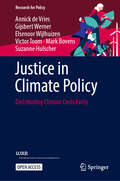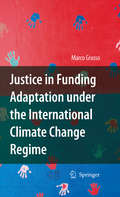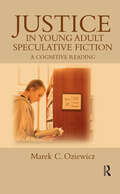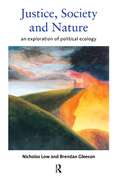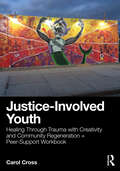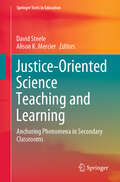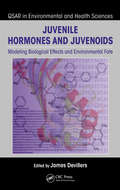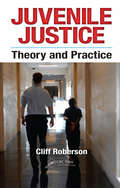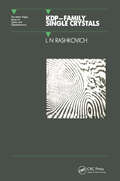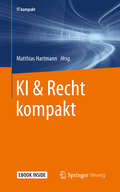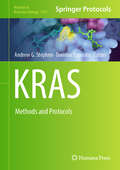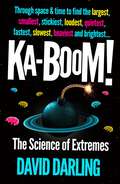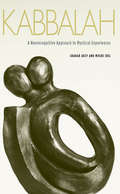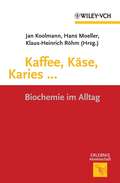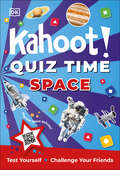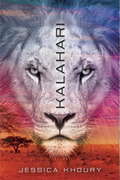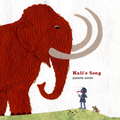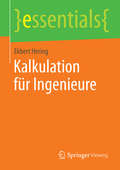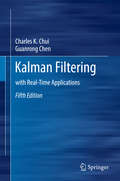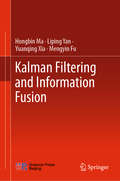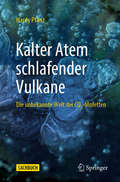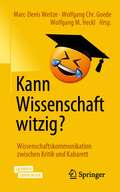- Table View
- List View
Justice in Climate Policy: Distributing Climate Costs Fairly (Research for Policy)
by Mark Bovens Victor Toom Annick de Vries Gijsbert Werner Elsenoor Wijlhuizen Suzanne HulscherThis open access book is looking into ways to achieve just climate policy within a country. The authors of this monograph share a unique, timely and original vision: continuous support for climate policy is more likely to emerge when citizens find that the distribution of the bill for climate costs is fair. But what is a fair distribution of climate costs? This is an important question because financial costs of mitigation (reducing greenhouse gases), adaptation (adapting to climate change) and damage (compensating or compensating after weather extremes) increase significantly in the coming decades. Drawing on philosophy and ethics, the authors propose ten principles for achieving just distributions of domestic climate costs. Examples of such principles are individual responsibility, the polluter pays, greatest utility and capacity to pay. Yet what a fair distribution is, depends on, for example, political preferences and the policy issue at hand. Empirical research on designing climate policies, however, shows that distributive principles are not part of the political, policy, and public discussions. The authors therefore argue that explicit attention to principles of just distribution at the start of a policy process contributes to support for climate policy. This book provides tools to professionals and students to achieve justice in climate policy.
Justice in Funding Adaptation under the International Climate Change Regime
by Marco GrassoCovering the ethical dimensions of international-level adaptation funding, a subject of growing interest in the climate change debate, this book provides a theoretical analysis of the ethical foundations of the UNFCCC regime on adaptation funding, one that culminates in the definition of a framework of justice. The text features an interpretative analysis of the ethical contents of the UNFCCC funding architecture by applying the framework of justice proposed to different areas of empirical investigation. The book offers scholars working on climate change, international relations, and environmental politics an analysis characterized by both theoretical soundness and empirical richness. The comprehensiveness of the book's approach should make it possible to plan and implement international adaptation funding more effectively, and eventually to define more just funding policies and practices.
Justice in Young Adult Speculative Fiction: A Cognitive Reading (Children's Literature and Culture)
by Marek C. OziewiczThis book is the first to offer a justice-focused cognitive reading of modern YA speculative fiction in its narrative and filmic forms. It links the expansion of YA speculative fiction in the 20th century with the emergence of human and civil rights movements, with the communitarian revolution in conceptualizations of justice, and with spectacular advances in cognitive sciences as applied to the examination of narrative fiction. Oziewicz argues that complex ideas such as justice are processed by the human mind as cognitive scripts; that scripts, when narrated, take the form of multiply indexable stories; and that YA speculative fiction is currently the largest conceptual testing ground in the forging of justice consciousness for the 21st century world. Drawing on recent research in the cognitive and evolutionary sciences, Oziewicz explains how poetic, retributive, restorative, environmental, social, and global types of justice have been represented in narrative fiction, from 19th century folk and fairy tales through 21st century fantasy, dystopia, and science fiction. Suggesting that the appeal of these and other nonmimetic genres is largely predicated on the dream of justice, Oziewicz theorizes new justice scripts as conceptual tools essential to help humanity survive the qualitative leap toward an environmentally conscious, culturally diversified global world. This book is an important contribution to studies of children’s and YA speculative fiction, adding a new perspective to discussions about the educational as well as social potential of nonmimetic genres. It demonstrates that the justice imperative is very much alive in YA speculative fiction, creating new visions of justice relevant to contemporary challenges.
Justice, Society and Nature: An Exploration of Political Ecology
by Nicholas Low Brendan GleesonJustice, Society and Nature examines the moral response which the world must make to the ecological crisis if there is to be real change in the global society and economy to favour ecological integrity. From its base in the idea of the self, through principles of political justice, to the justice of global institutions, the authors trace the layered structure of the philosophy of justice as it applies to environmental and ecological issues. Philosophical ideas are treated in a straightforward and easily understandable way with reference to practical examples. Moving straight to the heart of pressing international and national concerns, the authors explore the issues of environment and development, fair treatment of humans and non-humans, and the justice of the social and economic systems which affect the health and safety of the peoples of the world. Current grass-roots concerns such as the environmental justice movement in the USA, and the ethics of the international regulation of development are examined in depth. The authors take debates beyond mere complaint about the injustice of the world economy, and suggest what should now be done to do justice to nature.
Justice-Involved Youth: Healing Through Trauma with Creativity and Community Regeneration + Peer-Support Workbook
by Carol CrossIncluding a peer-support workbook with exercises, this book demonstrates the therapeutic value of art practice, both inside and outside institutions, as a more humane approach for children and adolescents affected by mass incarceration. The author discusses how a trauma-informed approach can heal marginalized and ignored citizens and refutes the notion that severe punishment for repeat offenders is essential or effective.Author Carol Cross has decades of experience incorporating therapeutic expressive arts in her professional practice, with a focus on peer-led programs. She advocates a trauma-informed approach using a peer-driven creative process, showing how such programs can intervene in the cycle of violence and contribute to a practice of community preventive care for youth deemed to be at risk. The workbook is built on the research and resources Cross has used within care plans with clinical teams and youth forensics. The user is shown how to build on these teachings and implement or modify the content to suit individual needs. Contributions from persons involved in the judicial system and such intervention programs vet the topics in the workbook as resonating with group participants.This user-friendly book will benefit anyone working with justice-involved children and adolescents, including those working in and around the criminal legal system as well as in programs outside of carceral institutions organized by individuals, groups, or non-profit organizations.
Justice-Oriented Science Teaching and Learning: Anchoring Phenomena in Secondary Classrooms (Springer Texts in Education)
by David Steele Alison K. MercierThis textbook provides K-12 science teachers and educators innovative uses of anchoring phenomenon-based teaching approaches from a justice-oriented lens (Morales-Doyle, 2017). It discusses topics such as the use of anchoring phenomenon-based pedagogies, qualities of productive anchoring phenomena and includes examples of unit plans that use anchoring phenomena and social justice science issues to create storylines to foster students’ multiple pathways to knowing and learning in the science classrooms. The book is beneficial to K-12 science teachers and science educators who are interested in facilitating students’ sense-making of a real-world phenomenon and engaging in three-dimensional science instruction (NGSS Lead States, 2013). By providing examples of unit plans based on theoretical groundings of anchoring phenomenon-based instruction and justice-oriented science teaching, this book provides a great resource to students, professionals, teachers, and academics in science education.
Justus von Liebig: Die organische Chemie in ihrer Anwendung auf Agricultur und Physiologie (Klassische Texte der Wissenschaft)
by Georg SchwedtBereits mit 21 Jahren erhielt Justus Liebig (1803-1873) auf Vorschlag Alexander von Humboldts, den er in Paris durch Gay-Lussac kennengelernt hatte, eine Professur für Chemie an der Universität Gießen. Dort entwickelte er die Elementaranalyse zu einer hohen Perfektion und isolierte, synthetisierte und analysierte zahlreiche organische Substanzen. Auf einer Reise durch England und Irland, verbunden mit einer Einladung der British Association for the Advancement of Science in Liverpool, besuchte er zahlreiche chemische Fabriken und wandte sich der angewandten Chemie zu. Auf Anregung der genannten Gesellschaft verfasste er 1840 einen Bericht zum Stand der organischen Chemie und Analytik unter dem Titel „Die organische Chemie und ihre Anwendung auf Agricultur und Physiologie“. Er begründete damit das Fachgebiet der Agrikulturchemie, formulierte darin erstmals den Gedanken eines Kohlenstoffkreislaufes und löste damit zugleich zahlreiche kontroverse Diskussionen aus.
Juvenile Hormones and Juvenoids: Modeling Biological Effects and Environmental Fate (QSAR in Environmental and Health Sciences)
by James DevillersJuvenile hormones (JHs) are a group of structurally related sesquiterpenes secreted by the insect corpora allata. They affect most insect life-cycle stages and physiological functions, including embryogenesis, larval and adult development, metamorphosis, reproduction, metabolism, diapause, polyethism, and migration. Juvenoids such as methoprene, hy
Juvenile Justice: Theory and Practice
by Cliff RobersonOver several hundred years, the juvenile justice system has evolved from one in which a child offender was prosecuted under the same guidelines used for adults to the current system in which society has recognized the unique status of juveniles within the criminal justice framework. Written by world-renowned legal scholar Cliff Roberson, Juvenile J
KDP - Family Single Crystals (Series In Optics And Optoelectronics Ser.)
by L.N RashkovichThe KDP family of single crystals is composed of compounds of alkali metals with light or heavy (hydro, deutero) water and oxides of phosphate or arsenate, including ammonium, potassium, rubidium and caesium dihydro- and dideutero-phosphates, and similar arsenates. While not occurring in nature, their production exceeds that of any other water-soluble crystals and the demand for bigger and more optically pure crystals is ever increasing. KDP-Family Single Crystals is a comprehensive investigation of the crystallization mechanism for these systems. The first part of the book collects the majority of the available data on the physico-chemical analysis of these systems. This is complemented by a review of contemporary concepts related to the crystal growth dislocation mechanism under the influence of impurities, changing supersaturation, and temperature. This is not only relevant to the growth of KDP single crystals but to the majority of crystals grown from low- and high-temperature solutions. Finally, attention is given to the important problem of speeding up the production processes for the growth of these crystals while maintaining the quality of the crystals. The in-depth coverage that KDP-Family Single Crystals provides to the art of crystal growth techniques makes it an essential reference work for all those working in the field of crystal growth and to those using KDP-family crystals in quantum electronics devices.
KI & Recht kompakt (IT kompakt)
by Matthias HartmannDas Buch gibt einen kompakten Einblick in alle wesentlichen Rechtsfragen rund um den Einsatz Künstlicher Intelligenz in Unternehmen oder Produkten. Versierte Autoren mit Praxiserfahrung erläutern die wichtigsten rechtlichen Themen beim Einsatz intelligenter Systeme und behandeln nach einer Einführung in die technischen Grundlagen die Auswirkungen und Besonderheiten Künstlicher Intelligenz in den Bereichen:ZivilrechtVertragsgestaltungLizenzierung HaftungImmaterialgüterrechte DatenschutzStrafrechtArbeitsrecht
KRAS: Methods and Protocols (Methods in Molecular Biology #2797)
by Andrew G. Stephen Dominic EspositoThis volume details protocols ranging from high yield production metabolically labeled KRAS for NMR studies to approaches that quantify engagement of novel molecules that bind KRAS in live cells. Chapters focus on protein production and characterization, biochemical assays, cell-based assays, KRAS-membrane interactions, targeting KRAS, and cell models. Written in the highly successful Methods in Molecular Biology series format, chapters include introductions to their respective topics, lists of the necessary materials and reagents, step-by-step, readily reproducible laboratory protocols, and key tips on troubleshooting and avoiding known pitfalls. Authoritative and cutting-edge, KRAS: Methods and Protocols aims to provide methods that will be instrumental in the development of future clinically approved KRAS therapeutics.
Ka-boom!: The Science of Extremes
by David DarlingWhat&’s the brightest light on Earth? The coldest corner of the universe? The blackest material ever made? The most poisonous substance in nature? &‘You will learn something new in every chapter, on every page and probably in every paragraph. Hugely entertaining.&’ Kit Yates, author of The Maths of Life and Death Ka-boom! probes extremes of size and speed, depth and density, and reveals the stickiest, sweetest, smelliest and nastiest substances known to science. In an unabashed celebration of the exceptional, David Darling takes an enlightening journey through the universe&’s weirdest and most wonderful extremes. Travel to far-flung galaxies in pursuit of habitable planets and extra-terrestrial life. Journey to the rainforests of South America and discover the top-speed of the notoriously sluggish sloth. Find out how Earth&’s hardiest creatures – tardigrades or &‘water bears&’ – ended up living on the moon. And meet the scientists and engineers using these quirks of nature to design faster computers, produce greener energy and revolutionise space travel.
Kabbalah
by Moshe Idel Shahar ArzyIn this book, the world’s foremost scholar of Kabbalah explores the understanding of erotic love in Jewish mystical thought. Encompassing Jewish mystical literatures from those of late antiquity to works of Polish Hasidism, Moshe Idel highlights the diversity of Kabbalistic views on eros and distinguishes between the major forms of eroticism. The author traces the main developments of a religious formula that reflects the union between a masculine divine attribute and a feminine divine attribute, and he asks why such an "erotic formula” was incorporated into the Jewish prayer book. Idel shows how Kabbalistic literature was influenced not only by rabbinic literature but also by Greek thought that helped introduce a wider understanding of eros. Addressing topics ranging from cosmic eros and androgyneity to the affinity between C. J. Jung and Kabbalah to feminist thought, Idel’s deeply learned study will be of consuming interest to scholars of religion, Judaism, and feminism.
Kaffee, Käse, Karies ...: Biochemie im Alltag (Erlebnis Wissenschaft)
by Jan Eds. KoolmanWhat is the kick we get from our morning cup of coffee or tea and why are we attracted by the smell of spices or perfume? How do the holes get in the cheese and why should you not clean your teeth after drinking a glass of wine? The authors have succeeded in explaining everyday objects in a scientific way to reveal hidden biochemical processes. This informative and richly illustrated book solves commonplace riddles in a readily comprehensible and entertaining manner, which you would probably not associate with biochemistry.
Kahoot! Quiz Time Space: Test Yourself Challenge Your Friends (Kahoot! Quiz Time)
by DKMore than 250 trivia questions for curious minds!What is the nearest neighbor to Earth? Do astronauts wear heated gloves? What is the force that pushes a rocket called? Find out in this quiz book, packed with questions and facts about space. Challenge yourself, your family, and friends with awesome questions based on the award-winning online Kahoot! games. Answer the questions, keep score, and declare the winner. Scan the QR codes throughout the book to find more cool quizzes on the same topics within Kahoot! and test your knowledge further. Go for gold and make learning awesome!
Kalahari
by Jessica KhouryDeep in the Kalahari Desert, a Corpus lab protects a dangerous secret...But what happens when that secret takes on a life of its own? When an educational safari goes wrong, five teens find themselves stranded in the Kalahari Desert without a guide. It's up to Sarah, the daughter of zoologists, to keep them alive and lead them to safety, calling on survival know-how from years of growing up in remote and exotic locales. Battling dehydration, starvation and the pangs of first love, she does her best to hold it together, even as their circumstances grow increasingly desperate. But soon a terrifying encounter makes Sarah question everything she's ever known about the natural world. A silver lion, as though made of mercury, makes a vicious, unprovoked attack on the group. After a narrow escape, they uncover the chilling truth behind the lion's silver sheen: a highly contagious and deadly virus that threatens to ravage the entire area--and eliminate life as they know it. In this breathtaking new novel by the acclaimed author of Origin and Vitro, Sarah and the others must not only outrun the virus, but its creators, who will stop at nothing to wipe every trace of it.
Kali's Song
by Jeanette WinterRenowned picture book author and illustrator Jeanette Winter brings us the enchanting story of a boy named Kali who lived thousands and thousands of years ago. Kali must learn to hunt, like the rest of the men in his tribe. But when Kali plucks the string on his bow, he forgets about shooting arrows, and makes music long into the night. Even the stars come close to listen. This lovely story, celebrating the uniqueness in all of us, the beauty of the natural world, and showing the power of music and art over violence, will be cherished by children everywhere.From the Hardcover edition.
Kalkulation für Ingenieure (essentials)
by Ekbert HeringDie Kalkulation errechnet Preise und Preisuntergrenzen für Produkte und Dienstleistungen. Sie liefert auch wertvolle Informationen für die Wirtschaftlichkeit, der Kostensenkung sowie der Erhöhung der Produktivität in allen Funktionen des Herstellungsprozesses. Behandelt werden die Methoden der Zuschlagskalkulation, die Berechnung der Maschinenstundensätze in der Fertigung sowie die Kalkulation mit Deckungsbeiträgen, mit Prozesskosten und die Kalkulation im Handel. Die klaren Strukturierungen ermöglichen dem Leser, seine Kalkulationsanforderungen in der Praxis sofort erfüllen zu können.
Kalman Filtering
by Guanrong Chen Charles K. ChuiKalman filtering algorithm gives optimal (linear, unbiased and minimum error-variance) estimates of the unknown state vectors of a linear dynamic-observation system, under the regular conditions such as perfect data information; complete noise statistics; exact linear modeling; ideal well-conditioned matrices in computation and strictly centralized filtering. In practice, however, one or more of the aforementioned conditions may not be satisfied, so that the standard Kalman filtering algorithm cannot be directly used, and hence OC approximate Kalman filteringOCO becomes necessary. In the last decade, a great deal of attention has been focused on modifying and/or extending the standard Kalman filtering technique to handle such irregular cases. It has been realized that approximate Kalman filtering is even more important and useful in applications. This book is a collection of several tutorial and survey articles summarizing recent contributions to the field, along the line of approximate Kalman filtering with emphasis on both its theoretical and practical aspects. "
Kalman Filtering and Information Fusion
by Yuanqing Xia Hongbin Ma Mengyin Fu Liping YanThis book addresses a key technology for digital information processing: Kalman filtering, which is generally considered to be one of the greatest discoveries of the 20th century. It introduces readers to issues concerning various uncertainties in a single plant, and to corresponding solutions based on adaptive estimation. Further, it discusses in detail the issues that arise when Kalman filtering technology is applied in multi-sensor systems and/or multi-agent systems, especially when various sensors are used in systems like intelligent robots, autonomous cars, smart homes, smart buildings, etc., requiring multi-sensor information fusion techniques. Furthermore, when multiple agents (subsystems) interact with one another, it produces coupling uncertainties, a challenging issue that is addressed here with the aid of novel decentralized adaptive filtering techniques.Overall, the book’s goal is to provide readers with a comprehensive investigation into the challenging problem of making Kalman filtering work well in the presence of various uncertainties and/or for multiple sensors/components. State-of-art techniques are introduced, together with a wealth of novel findings. As such, it can be a good reference book for researchers whose work involves filtering and applications; yet it can also serve as a postgraduate textbook for students in mathematics, engineering, automation, and related fields.To read this book, only a basic grasp of linear algebra and probability theory is needed, though experience with least squares, navigation, robotics, etc. would definitely be a plus.
Kalter Atem schlafender Vulkane: Die unbekannte Welt der CO2-Mofetten
by Hardy PfanzDieses auch für den interessierten Laien verständlich geschriebene Werk führt in die unbekannte Welt der CO2-Gasvulkane, der sogenannten Mofetten, ein. Eine wenig erforschte Welt, die inmitten von Europa Tiere sterben lässt, die Pflanzenwelt verändert, Böden und Atmosphäre beeinflusst und Hinweise für kommende Vulkanausbrüche liefern kann. Mithilfe der botanischen Bioindikation können solche Entgasungsstellen auch im Gelände gefunden und sogar wirtschaftlich genutzt werden, z.B. in Mineralwässern und Feuerlöschern, bei der Haltbarmachung von Nahrungsmitteln sowie bei der Heilung von Herz- und Hautkrankheiten. Prof. Hardy Pfanz erklärt in diesem biologisch-geologischen Mofettenführer, wo solche Erscheinungen in Deutschland, aber auch weltweit, gefunden werden können und was sie uns sagen. Auch verrät er –augenzwinkernd– das ein oder andere Außergewöhnliche und Sagenhafte über Mofetten.
Kamala's Art (Houghton Mifflin Vocabulary Reader Accompanies Journeys)
by Yuri Lubov Mary YoungNIMAC-sourced textbook <P><P>Level H DRA 14 Science Strategy
Kangaroos and Other Marsupials (World Book's Animals of the World)
by Julie A. FentonHave you always wondered what the difference between a Kangaroo, a Wallabee, and a Wallaroo is? Did you know that when Tasmanian Devils are angry their ears turn bright red? Did you know that Koalas smell like cough drops? Find out the answers to these and other fascinating facts in this informative book on marsupials, animals with pouches.
Kann Wissenschaft witzig?: Wissenschaftskommunikation zwischen Kritik und Kabarett
by Marc-Denis Weitze Wolfgang M. Heckl Wolfgang Chr. Goede"Kann Wissenschaft witzig?“ nimmt ein ebenso innovatives wie zukunftsträchtiges Element moderner Wissenschaftskommunikation unter die Lupe: Die Komik!Leserinnen und Leser werden durch anschaulich gehaltene akademische Theorie sowie spannende Hands-on- und Best Practice-Beispiele renommierter Praktiker und Kabarettisten geführt:· Was haben Schafskäse und Autoreifen gemeinsam?· Kann Lachen Mauern einreißen lassen?· Wie funktioniert „Die Anstalt“· Wie schafft Zauberkunst Wissen?· Gibt es Humor im Museum?· Kommt ein Dalmatiner an die Kasse· Drei Schritte zum Humor· Serviervorschlag für den Heiligen Geist· Diktatur der Dummheit· Und viel mehr!Das ist aber nicht alles nur lustig. Komik kann auch Kritik etwas von ihrer beißenden Schärfe nehmen, die Kritik für die Adressaten verdaulich, ja sogar schmackhaft machen.„Kann Wissenschaft witzig?“ navigiert zwischen Kritik und Kabarett und setzt sich mit Komik in verschiedenen Spielarten aus unterschiedlichen Perspektiven auseinander. 22 Beiträge zeigen, wie sich die Ergebnisse von Wissenschaft, Forschung, Technologie auf neuen Wegen in die breite Öffentlichkeit tragen lassen. Sie demonstrieren insbesondere auch, wie Humor sich als kritisch-fragende Kraft einsetzen lässt – wertvoll für sämtliche Kommunikationsarten und hilfreich, damit sie in Zukunft gewitzter daherkommen.
